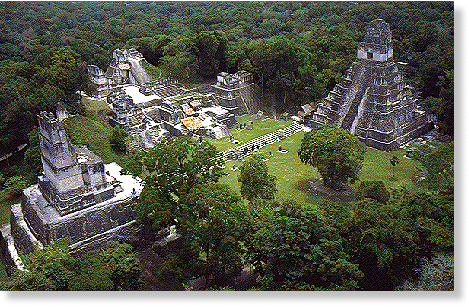
© Unknown
Decades of extreme weather crippled, and ultimately decimated, first the political culture and later the human population of the ancient Maya, according to a new study by an interdisciplinary team of researchers that includes two University of California, Davis, scientists.
The collapse of the Maya is one of the world's most enduring mysteries. Now, for the first time, researchers have combined a precise climatic record of the Maya environment with a precise record of Maya political history to provide a better understanding of the role weather had in the civilization's downfall.
Their findings are published in the Nov. 9, 2012 issue of the journal
Science.
"Here you had an amazing state-level society that had created calendars, magnificent architecture, works of art, and was engaged in trade throughout Central America," said UC Davis anthropology professor and co-author Bruce Winterhalder. "They were incredible craftspersons, proficient in agriculture, statesmanship and warfare - and within about 80 years, it fell completely apart."
To determine what was happening in the sociopolitical realm during each of those years, the study tapped the extensive Maya Hieroglyphic Database Project, run by UC Davis Native American Language Center director and linguist Martha Macri, a specialist in Mayan hieroglyphs who has been tracking the culture's stone monuments for nearly 30 years.
"Every one of these Maya monuments is political history," said Macri.
Inscribed on each monument is the date it was erected and dates of significant events, such as a ruler's birthday or accession to power, as well as dates of some deaths, burials and major battles. The researchers noted that the number of monuments carved decreased in the years leading to the collapse.
But the monuments made no mention of ecological events, such as storms, drought or references to crop successes or failures.
For that information, the research team collected a stalagmite from a cave in Belize, less than 1 mile from the Maya site of Uxbenka and about 18 miles from three other important centers. Using oxygen isotope dating in 0.1 millimeter increments along the length of the stalagmite, the scientists uncovered a physical record of rainfall over the past 2,000 years.
Combined, the stalagmite and hieroglyphs allowed the researchers to link precipitation to politics. Periods of high and increasing rainfall coincided with a rise in population and political centers between 300 and 660 AD. A climate reversal and drying trend between 660 and 1000 AD triggered political competition, increased warfare, overall sociopolitical instability, and finally, political collapse. This was followed by an extended drought between 1020 and 1100 AD that likely corresponded with crop failures, death, famine, migration and, ultimately, the collapse of the Maya population.
"
It has long been suspected that weather events can cause a lot of political unrest and subject societies to disease and invasion," Macri said. "But now it's clear. There is physical evidence that correlates right along with it. We are dependent on climatological events that are beyond our control."
Said Winterhalder: "It's a cautionary tale about how fragile our political structure might be. Are we in danger the same way the Classic Maya were in danger? I don't know. But I suspect that just before their rapid descent and disappearance, Maya political elites were quite confident about their achievements."
Co-authors leading the study are Douglas Kennett of Pennsylvania State University and Sebastian Breitenbach of Eidgenossische Technische Hochschule in Switzerland. The research was funded by the National Science Foundation, the European Research Council and Alphawood Foundation.
So it appears 'climate change' precipitated the collapse of the Maya culture! Must have been those dam SUV's they were driving!